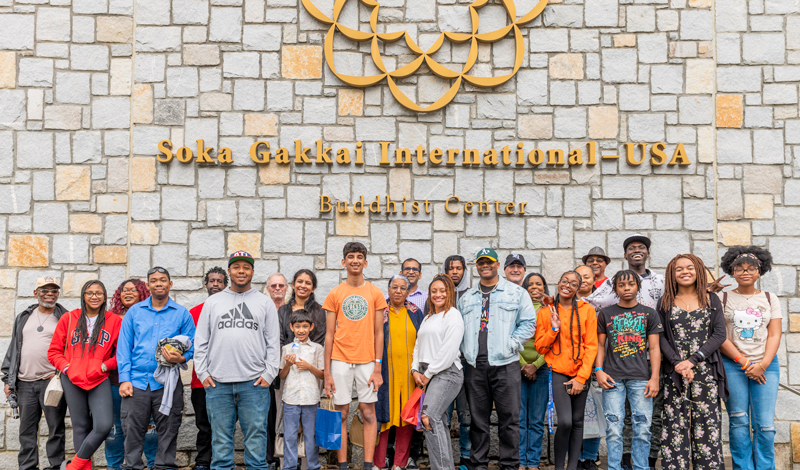If the spirit of many in body but one in mind prevails among the people, they will achieve all their goals, whereas if one in body but different in mind, they can achieve nothing remarkable.
—“Many in Body, One in Mind,” The Writings of Nichiren Daishonin, vol. 1, p. 618
This vital passage appears near the beginning of “Many in Body, One in Mind,” a letter Nichiren Daishonin wrote sometime between 1275 and 1280 to encourage his embattled disciples in Atsuhara Village (present-day central Shizuoka Prefecture).
Around 1275, what came to be known as the Atsuhara Persecution began and continued until about 1283. At that time, Nichiren’s disciples in Atsuhara and the surrounding area, led by Nikko Shonin, had been making great strides in spreading Nichiren’s teachings. Alarmed by their progress, the authorities used threats and acts of violence to pressure them to give up their faith.
As the oppression intensified, Nichiren wrote this letter emphasizing the importance of unity based on the spirit of “many in body, one in mind” as the key to surmounting such great trials. “Many in body” indicates mutual respect among diverse individuals, and “one in mind” means to cherish the same lofty goal or ideal.
In 1279, at the height of this persecution, authorities arrested 20 disciples on false charges, interrogating and torturing them, demanding they renounce their faith in the Daishonin’s teachings. But not one yielded in their faith.
—Prepared by the SGI-USA Study Department
Ikeda Sensei’s Encouragement
1. Unity in Diversity
To quickly reconfirm the meaning of the concept of “many in body, one in mind,” many in body—which can also be expressed as “different in body”—refers to people’s diverse personalities and characteristics, and the roles they have to fulfill. One in mind—which can also be expressed as “same in heart or spirit”—generally means sharing the same purpose or values. It also means cherishing a shared wish or aspiration to realize a lofty goal or ideal.
In terms of Buddhism, the core of “being one in mind” is faith based on the oneness of mentor and disciple—that is, each person taking kosen-rufu, the Buddha’s will and intent, as a personal mission and actively working for its realization. For disciples to take on challenges and strive to win with the same spirit as their teacher is the essence of the spirit of many in body, one in mind. …
Though we may share the same purpose or aspiration, we do not suppress or deny our own individuality. When we each fully express our unique potential through the power of the Mystic Law, we can manifest the invincible strength of the unity of many in body, one in mind. …
Only when we each bring forth the wisdom of our enlightened Buddha nature can we truly actualize the unity of many in body, one in mind as taught in Nichiren Buddhism. Because we rise above our attachment to self and reveal our highest potential and individuality, the path of many in body, one in mind becomes a path for absolute victory.
Here, we should also remember that, through manifesting the wisdom of our Buddha nature, we can break free from the fundamental darkness or ignorance that would keep us trapped in the paths of evil and suffering. The spirit of many in body, one in mind is not a unity achieved through external constraints or demands for conformity. Rather, it is an expression of the wisdom of our Buddha nature arising from a fundamental liberation occurring in the depths of each person’s life. It is a unity based on aligning our own hearts with the heart of the Buddha. (Learning from the Writings: The Hope-filled Teachings of Nichiren Daishonin, pp. 205–06)
2. Conquer the Tendency to Focus on Differences
A mind prone to making distinctions of self and other leads one to self-isolation, to self-attachment and to regarding the self as faultless, which gives rise to evil and misery. Depending on the person and the situation, such negative traits as contempt, hatred, jealousy, resentment, indignation, arrogance, malice, sullenness, gloom, stubbornness, impatience, disloyalty and ingratitude may arise. People who transcend attachment to the self and bring forth the power of the Mystic Law free themselves from a negative life tendency that confines one to evil and suffering. …
Those who have conquered the tendency to focus on differences come to manifest in their lives the workings of the Mystic Law, which connects and harmonizes all things. At times, they will play a leading role and freely take initiative for kosen-rufu, while at other times, they will work behind the scenes to support other central figures. Moreover, whatever capacity they fulfill, their lives will pulse vibrantly due to the Mystic Law, the fundamental power of the universe. (The Hope-filled Teachings of Nichiren Daishonin, p. 213)
You are reading {{ meterCount }} of {{ meterMax }} free premium articles

